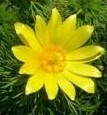
Native to dry grasslands of Europe and Asia, this herbaceous perennial is a member of the buttercup family, Ranunculaceae, that also includes anemone, delphinium, and hellebore. The plant forms a clump beginning with the emergence of the single flower buds on a stout stem. As the flower opens leaves unfurl and the unbranched stem elongates to 12-18″ tall as seeds form. The sessile leaves are highly dissected, fern-like, and 1-2″ long. The butter yellow flowers appear in spring and are 2-3″ across, have 10-20 petals, and open flat. Although spring Adonis is poisonous, it has a long history of use in European and Chinese medicine to treat a variety of health issues from edema and panic disorder to kidney and heart disease. The plants are very rare and difficult to propagate but would look lovely in a rock garden or in the front of a border where they should be massed to produce a striking display. Since the plants die down for summer, annuals or other plants should be planted in the vacated space. The genus name, Adonis, honors the Greek god of plants and rebirth. The specific epithet, vernalis, comes from the Latin word vernus, meaning spring, and refers to the bloom time.

Type: Herbaceous perennial
Bloom: Yellow flowers 2-3″ across in spring
Size: 12-18″ H
Light: Full sun to part shade; needs afternoon shade in hot climates
Soil: Average, medium moist, well-drained; somewhat drought tolerant when established
Hardiness: Zones 4-7 (needs about six weeks of temperatures below 40 F for the rhizomes to break dormancy in spring)
Care: Low maintenance
Pests and Diseases: None of significance but slugs can be a problem
Propagation: Seed, division after foliage dies down in late spring; propagation is very difficult and plants resent transplanting.
Companion Plants: Plants die down in the summer and the spaces can be filled with annuals.
Photo Credit: Wikipedia